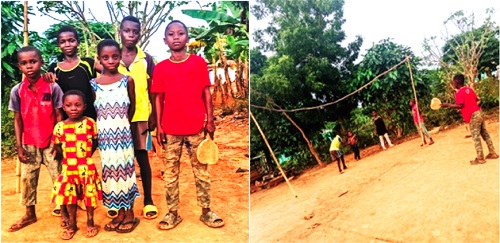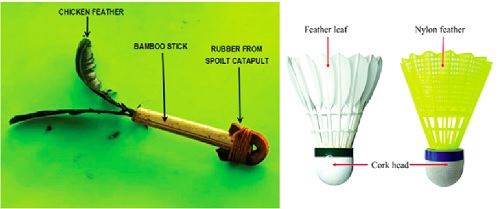
The sour sports story of Ghana
On the afternoon of August 26, 2022, I sat under a tree in a village called Anyanso in the Bosome-Freho District, with a few of my paternal cousins.
Advertisement
Something delicious-smelling was boiling in a soot-stained pot on an open-pit fire while I casually took photographs with my phone.
My attention was soon drawn to a few kids playing nearby by their yells and shouts of excitement.
It was pure nostalgia; “Chaskele” was on my mind.
They jumped, shouted and ran around.
Their energy was infectious.
This was bliss.
They had set up a stick that looked like a goalpost.
I got a little more curious when I noticed only one pole.
Then I suddenly realised that it was rather a median “net” of some sort.
These kids were playing their own form of “badminton”.
So, I walked closer, and to my amazement, I saw they had skillfully set up their own badminton court, net, wooden rackets and shuttlecock.
Ingenuity! Imagination!! Resourcefulness!!! Self-Reliance!!!!
From left to right (front row) – Esther Appiah and Florence Antwi
From left to right (back row) – Gideon, Ralphael Akwesi Bonsu, Simon Akwesi Akwah and Simon Kofi Anokye
There were “players’ on either side and one was acting as umpire.
I called them, had a chat with them and took a group photograph to complete the sports imaging.
The astonishing part was when I saw their own version of their fabricated “shuttlecock”.

The “Anyanso kids’ Shuttlecock” compared with a standard Shuttlecock
It was made from a couple of feathers, short thin bamboo sticks and a combination of rubber bands and remnants of a broken catapult.
These were what rushed through my mind…creativity at its best… raw talent… intuitive material science… practical physicists… and more!!!
The “Anyanso kids’ Shuttlecock” compared with a standard Shuttlecock.
These were a group of kids in a village in the middle of nowhere, who had taken into their own hands the challenge of taking care of their sports needs.
I was even more excited that it was not presumably soccer, but rather what we label as “lesser sports”.
This summarises my sour sports story of Ghana.
Paper
More than 25 years ago, I presented a paper advocating for Affordable Sports Facilities at a forum in Accra organised by Mr Magnus Rex Danquah of RICS Consult and the Ministry of Youth and Sports on the theme: Establishing Ghana Sports as an Emerging Industry.
As a young architect then, though I was nervous, I was also very inspired by the minds that gathered on the day.
I was expecting to be impressed as a young man.
I was thrilled to be flanked on both sides by two of my teachers: Mr Joseph Dottey, who taught me at the Presbyterian Middle Boys’ Boarding School (Osu Salem), and the late Arc. Wellington Enninful, who taught me in the School of Architecture at KNUST, Kumasi. May he rest in peace.
However, by the time it got to my turn to deliver, I was getting disillusioned.
I rose and asked a simple question of all those gathered; where are our sportsmen going to come from?
What sports infrastructure is available at the grassroots and close to where the talent would come from?
Mr Dottey, then with the Institute of Public Relations, and Arc. Enninful, then a lecturer at KNUST, had designed the Len Clay Stadium at Obuasi.
Both were there to present papers. Arc. Enninful presented a paper on Standards Required for Sports Stadiums and Mr Dottey talked about the Public Relations aspects of sports.
Here I was, seated to speak on behalf of the next generation.
My question on the day was simple; where were all these speakers, touting lofty ideas, going to get the raw talent from to turn into big business?
These questions are even more relevant today than they were more than 20 years ago.
Nii Ayikai Adjin-Tettey, who was present, was teary.
This is one question we have failed to answer in all spheres of sports, including soccer.
For those who do not know Mr. Nii Ayikai Adjin-Tettey, let me state that he died at 91 in 2021.
He was an athlete himself and became the National Athletic Coach afterwards.
● What was our youth policy then?
● What is our youth policy now?
●What is our policy towards sports development, regarding the youth? Not only soccer but all sporting disciplines?
● How much effort is this nation putting into developing talent into winning teams and individuals?
● Where are the next generation of Azumah Nelson, Frank Ofori, Miles Mills, etc.?
● On which tennis courts, basketball courts, tartan tracks and boxing rings would the youth train?
●What incentives are there to engage in sports development?
Our youth are sadly on their own.
The government takes policy direction from the Sports Act 2016 (Act 934).
The Object of the Sports Authority, among others, is to:
a. promote and encourage the organisation, development of, and mass participation in, sports,
b. encourage increased participation and improved performance in sports, and
c. encourage the private sector to contribute to the funding, development and promotion of sports. Section 2, Sports Act 2016 (Act 934)
Weak
This Sports Act is clearly weak on actions and finance to harness the talent of our young ones from the grassroots, wherever they may be in Ghana.
The invitation to the Private Sector to partner with the sports authority should be rewarding and mutually beneficial.
The story about contemporary Ghanaian sports has turned sour.
What incentive is being put in place to get the private sector to invest in the development of tennis, swimming or basketball, for instance?
It is time for our sports authorities to be deliberate about sports development.
The Sports Act is not strong on the spatial implications of sports.??
Sections 24 and 24?? focus on the District Sports Units, which, together with the Metropolitan/Municipal/District Chief Executives, are enjoined to initiate and manage sports activities in the MMDAs.
The Act or relevant subsidiary legislation must empower the assemblies to do more with the District Planning Co-ordinating Unit to ensure that our youth get places to play and develop the spirit of competition.
The other aspects of sports, such as refereeing, developing sports infrastructure like grassing, pitch marking, cheerleading and even sports marketing, make sports development complete.
These spaces should have the same status as Public Open Spaces so that their use could only be altered by parliament.
We seem to have some initiatives for now, but we certainly need to do more.
The recent investment in large sports complexes and parks made of Astro-turf is a policy that must be reviewed.
These are huge and concentrated investments which may not be reaching many young people.
Another concern is the artificial nature of many pitches springing up all over the place.
These astro turfs could become a problem for the country sooner or later.
The eventual disposal of plastic artificial grass would be a problem.
The European Union has banned the development of artificial turf from 2030 because they have observed that it is the source of microplastics in the environment, which is harmful.
So many of the pitches are being re-grown into natural pitches.
Why would we want to start a problem that the developed world is running away from?
Many football stars and administrators in Ghana have called for a ban on artificial pitches.
Notable among them are Samuel Osei Kuffour and George Afriyie.
It has been proven that it has a higher rate of foot and ankle injuries as compared with natural grass pitches.
Notwithstanding, we have rather gone on a spree. For a tropical country like ours, why do we have this affinity for artificial pitches when we can grow natural grass?
Let’s also learn to grow our young talents.
It is time to stop, rethink and redirect Ghana’s sports story and philosophy.
This story is getting sour.
The writer is an architect.




